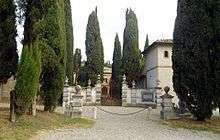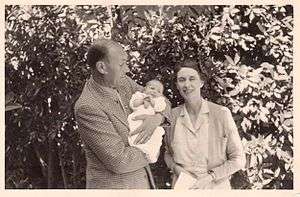La Foce
La Foce is a large estate that lies close to the towns of Montepulciano, Chiusi, and Chianciano Terme in the Southern Tuscan region of Val d'Orcia midway between Florence and Rome.[1]
History


La Foce, situated on the Via Francigena (the ancient road and pilgrim route running from France to Rome), has been inhabited continuously for many centuries. The Villa at La Foce was built in the late 15th Century as a hospice for pilgrims and merchants traveling on the Via Francigena.[1]
La Foce is located near an Etruscan settlement, and on the property, a burial-place dating from the 7th century BC to the 2nd century AD has been excavated.[1]
Restoration
In 1924, Iris Origo, the writer who was a granddaughter of both William Bayard Cutting and Hamilton Cuffe, 5th Earl of Desart, and Antonio Origo, the son of Marchese Clemente Origo, bought the dilapidated estate and moved there shortly after their marriage.[2] The estate's late-15th-century villa was restored by the Origos in the 1920s,[3] with financial assistance from the Fascist government of Mussolini.[4] The gardens, considered amongst the finest in Italy,[5] were designed by the English architect, Cecil Pinsent, who also designed the gardens at Villa Le Balze.
The Origo's employed 25 families on the estate and started a school for the 50 or so children of the workers, teaching them to read and providing for their well-being.[3] The Origo's also built 35 farmhouses in the 1920s and 1930s to house their tenant farmers.[6]
After the death of Iris and Antonio, their daughters sold off approximately two-thirds of the estate and divided the rest between them.[6] Descendants of the family still own the property today and operate it as a luxury resort.[7]
In popular culture
The book War in Val d'Orcia by Iris Origo is set in this estate,[6] which at the time contained 57 farms in 7,000 acres.[8]
Incontri in Terra di Siena, an international music festival, is held at Castelluccio, a medieval castle on the property.[9] The festival is held in memory of Iris and Antonio Origo each July.[10][5]
References
- 1 2 3 "History - La Foce". www.lafoce.com. Retrieved 25 April 2018.
- ↑ "La Foce | Benedetta Origo, Morna Livingston, Laurie Olin, John Dixon Hunt". www.upenn.edu. University of Pennsylvania. Retrieved 25 April 2018.
- 1 2 Weber, Nicholas Fox (21 July 2002). "Under the Tuscan Sun". The New York Times. Retrieved 25 April 2018.
- ↑ Thomson, Ian (11 November 2017). "Mussolini's fall from grace | The Spectator". The Spectator. Retrieved 25 April 2018.
- 1 2 Dabbagh, Selma (6 July 2012). "Iris Origo: The Author Honoured By a Music Festival". The Guardian. Retrieved 25 April 2018.
- 1 2 3 Laskin, David (9 May 2014). "Echoes of History at a Tuscan Estate". The New York Times. Retrieved 25 April 2018.
- ↑ Burke, Francesca Gilberti (August 3, 2016). "5 Places to Host the Perfect Tuscan Wedding". Architectural Digest. Retrieved 25 April 2018.
- ↑ Iris Origo: War in Val d'Orcia Jonathan Cape, London, 1947, p.8
- ↑ "Music and beauty in Tuscany, a winning duo". Euronews. 4 July 2013. Retrieved 25 April 2018.
- ↑ Incontri in Terra di Siena at itslafoce.org
Further reading
- La Foce Official website. Accessed 5 August 2013
- Campbell. Katie Iris Origo's La Foce pp 154-167 of Paradise of Exiles: the Anglo-American gardens of Florence, Frances Lincoln 2009. ISBN 9780711229563